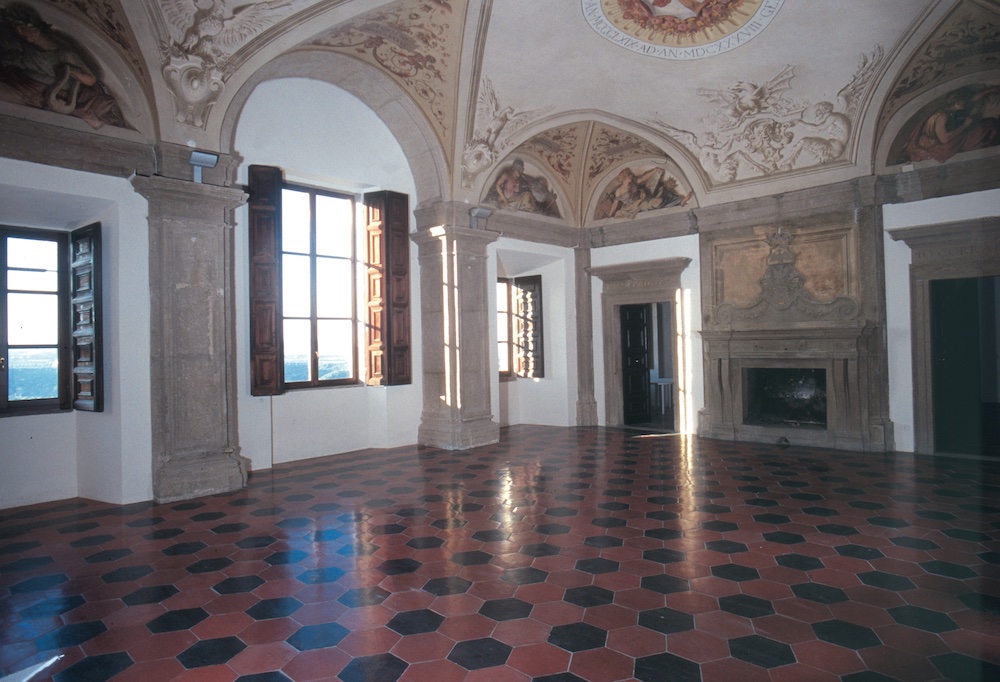in the signofVicino
Orsini Palace
The construction phases of Palazzo Orsini are linked to the events of the underlying Sacred Forest of Pier Francesco, or Vicino Orsini born in Bomarzo on July 4, 1523. His father Giovanni Corrado Orsini, already the widower of Lucrezia Anguillara, married Clarice Orsini, daughter of Cardinal Franciotto, on April 29, 1520.
As early as December 29, 1519, the Sienese architect and painter Baldassarre Peruzzi had designed the first wing of the new palace, close to the church and featuring a courtyard, loggia, staircase and other divisions. Peruzzi was also an impresario taking advantage of the presence on the site of his half-brother painter Pietro Antonio di Andrea. From 1520 to 1524 the chisel works up to the second floor are due to Pier Domenico Ricciarelli; those after 1524, that is, of the mezzanines and cornice, to Bartolomeo di mastro Giovanni da Morco in the diocese of Como. To avoid the bottlenecks of the medieval village, Peruzzi designed and built the route of a new access road, which is also documented in a view in the Sienese notebook S.IV.7. Between 1521 and 1533 under the castle, palace, and hamlet, a large area was acquired to create a terraced garden, sloping down towards the valley and connected to the new road system.
In 1526 the new wing of the palace was not yet finished, so much so that Giovanni Corrado Orsini instructed his sons to finish it, then possibly to work on the adjoining older wing. A sketch by Peruzzi preserved in the Uffizi (U 579 retto) shows the plan of the palace with the loggia, the courtyard and the staircase at the junction of the two wings, the new one partly built and the old one still to be transformed.
When Giovanni Corrado Orsini died on September 21, 1535, it was his son Pier Francesco, or Vicino, who had the new Peruzzi wing completed. Thus at the covered courtyard two first-floor windows and the ground-floor entrance portal are engraved with Vicino’s name. Married in Jupiter on January 11, 1544, to Giulia, daughter of Galeazzo Farnese, Vicino Orsini, on the second floor of the ancient wing, built his own apartment known as the Galleria, now the town hall, and further enlarged after his wife’s death, between 1560 and 1583.





The loggia, squared off on two adjoining sides, is now used as a council chamber. It was not until 1552 that the sculptor and architect Francesco Moschino was present in Bomarzo and much later his son Simone Moschino and a group of Florentine stonemasons, all in the service of Orsini. The basement of the Peruzzi wing was for kitchens and services, the first floor for public relations and justice; the second floor and mezzanine for living quarters.
After Giulia Farnese’s death, Vicino Orsini lived in the Galleria apartment; the first floor of the Peruzzi wing was used by her son Corradino Orsini and Margherita Sabella, while the second floor was allocated to her other son Marzio Orsini and Porzia Vitelli.
In fact, around 1575 the middle room on the second floor was painted, possibly by the Viterbese Orazio Bernardo di Domenico, with a frieze containing the Orsini and Vitelli coats of arms and views of the castles of either family. In 1564 for a loggia in the Annibal Caro palace he provided instructions for painting the fable of the Giants, perhaps still hidden if not destroyed. In 1645 Bomarzo and Palazzo Orsini were sold to Duke Ippolito Lante della Rovere, who had the great hall on the second floor built in whose vault, in 1660-1661, the Cortonese painter Lorenzo Berrettini executed the allegory of War and Peace.
The stone doors on the second floor are from the 17th century; those by Peruzzi are all on the first floor. In 1836 the palace passed to the Borghese family, to whom we owe the small room with views of the castles of Mugnano, Chia and Attigliano.
Bomarzo
The oldest settlement most likely arose and established around the 6th century BC with functions of surveillance and control of trade routes along the Tiber valley. It maintained commercial and cultural relations with the town of Ferento (Acquarossa), but also with the more inland centers of Etruria, such as Chiusi, Perugia, and Velzna, today’s Orvieto.
